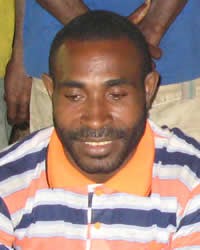Waxe, Watakataui in Papua New Guinea

Photo Source:
Anonymous
|
Send Joshua Project a map of this people group.
|
| People Name: | Waxe, Watakataui |
| Country: | Papua New Guinea |
| 10/40 Window: | No |
| Population: | 900 |
| World Population: | 900 |
| Primary Language: | Watakataui |
| Primary Religion: | Christianity |
| Christian Adherents: | 80.00 % |
| Evangelicals: | 60.00 % |
| Scripture: | New Testament |
| Ministry Resources: | Yes |
| Jesus Film: | Yes |
| Audio Recordings: | No |
| People Cluster: | New Guinea |
| Affinity Bloc: | Pacific Islanders |
| Progress Level: |
|
Introduction / History
The Waxe, as they refer to themselves, were surveyed while they concentrated in the village of Watakataui along the Wisas tributary. In the 1960s, under the advisement of the government officers, or kiaps, they moved to a piece of ground on a larger and more accessible river. Its population was 225 in the 1980 census. This is around the same time New Tribes Mission began its work among the Waxe. Present population is roughly 700.
Where Are they Located?
The Waxe are now concentrated in two villages along the Krosomeri (Angry Woman) River in the East Sepik Province of PNG. The larger village of Meska, is home to roughly 450 people, and Wenim is home to roughly 250 as of 2015.
What Are Their Lives Like?
Because of the remoteness of these two villages, most of the Waxe have never left their ancestral ground. They are hunters and gatherers but not nomadic. Despite efforts to improve their economic status, transportation of goods (rubber, dried fish, spices, etc.) to market has traditionally been a hindrance. In recent years that has improved and the group does transport cocoa beans to market in Maprik or Wewak. They are governed by a local 'Councillor' who serves as a mayor and representative to the Provincial Government in Wewak. They also have a local Magistrate to settle local disputes. Much of their daily lives is taken up with mere existence...gathering firewood, harvesting sago, fishing and gardening. Family units are part of larger clans, which closely monitor the arrangement of marriages. They have no electricity or other services, and their only access to larger population centers and services is primarily by river. Recently they have acquired cell service, though it is erratic.
What Are Their Beliefs?
Traditionally animistic, the Roman Catholic church reached the Waxe first, around 1960. New Tribes Mission brought the gospel of grace roughly 20 years later. The first evangelical church was planted in 1986 in Wenim, and in 1988 a second was established in Meska. In the years since they have moved from their animistic belief system toward a biblical lifestyle as followers of Christ. The two evangelical churches are led by teams of elder and deacons. Recently they received the New Testament and Old Testament portions in their mother tongue. While there are still some who will resort to animism and ancestor mediation, the vast majority of the population have left that previous belief system.
Prayer Points
Continued growth and unity of the elders, deacons and other church leaders.
A greater understanding of God's grace in their daily lives.
Literacy program and improvement of reading skills that will allow them to read New Testament.
Regular, open communication lines with mission contacts in Wewak.